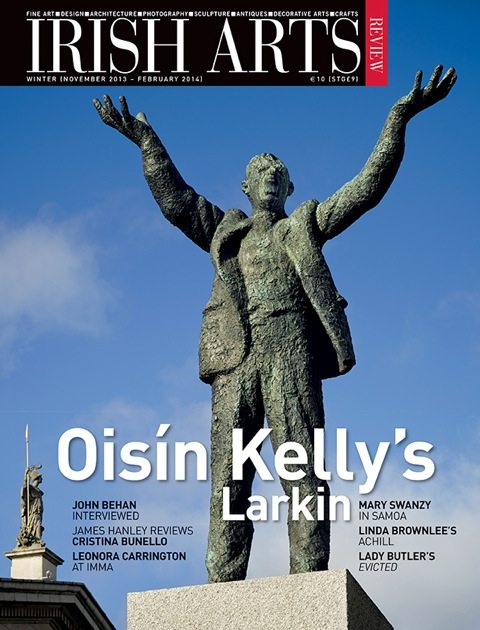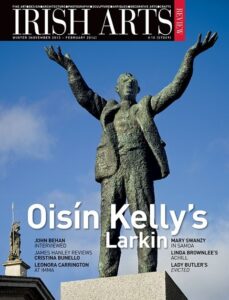

Achill’s desolate beauty has inspired many Irish artists, not least Linda Brownlee who has captured the island’s youth caught between land, sea and sky, writes Stephanie McBride
Achill’s defining characteristics were described by The Westminster Review in 1890 thus: ‘‚Ķfor if Nature has been niggardly in bestowing fruitfulness on the soil, she has richly endowed the island with scenic gifts.’ Two decades later, Paul Henry on his first visit to the island also noted the impoverishment of the land. ‘It meant incessant toil with the spade, ploughs being useless on those stony fields,’ he wrote in his autobiography and depicted this labour in his painting The Potato Diggers in 1923. Initially encouraged by Synge to visit Achill, Henry lived there for several years. His distinctive visual style and representation of its island life was adopted and promoted by the new State as the official image of Ireland, melding his artistic perception with constructs of national and cultural identity. In a contrasting style but echoing Henry’s rural content, Gerard Dillon’s disarmingly direct mode – at times invoking a surrealist turn – presented further images of life on the western seaboard. More recently Alannah O’Kelly’s striking 1990 work The Country Bloom, A Garden and a Grave reconfigures Achill’s topography through image and text to present a narrative of local loss, mourning and Famine memories.
Historically, then, Achill’s landscape and terrain are already symbolically laden and layered within Irish visual discourse. A recent series by London-based Irish photographer Linda Brownlee continues this engagement with the island. Brownlee’s portrait, fashion and documentary work has featured in The New York Times, Nylon and Vogue as well as the National Portrait Gallery, Host Gallery, Printspace, the Nottingham Museum and Art Gallery. She was a frequent summer visitor to the island as a teenager, and in her recent book Achill her carefully-made portraits of local teenagers in the landscape prompts us to reconsider the topographical and emotional contours of this environment and locale. Tough grass and bushy scrub enfold a lone male figure in this unyielding rough landscape. A young woman wrapped in her own thoughts is caught against a wide, spacious stretch of pale coast and sky. Another’s dark clothing sets her in relief against an almost blank canvas of uncertain boundaries and horizons (Fig 1). Bog, hills and sky surround another young woman on a rough lane, leading to a mountain reminiscent of a Henry painting (Fig 7). In another portrait, a girl looks out to sea, the textures and tones of the natural landscape contrasted with her startling bright red top (Fig 6).
Throughout these images, the grandeur, shards and mountainous monuments of the island’s geography accentuate the human figure and its place in the landscape. If the picturesque defines terrain as a landscape to be viewed (by a tourist or other spectator) rather than a place to be lived in, Brownlee overturns this by situating her subjects as rooted in and intimate with their landscape. This resistance to the purely scenic is asserted in the image where a line of telegraph poles in spectral outline are dotted along a grey road toward a misty horizon, denying the isolation beloved of a more Romantic mindset. Another image shows caravans anchored in the landscape on an overcast day, almost eclipsed by the dark cliffs fading into the distance (Fig 4). The presence of the caravans – that emblem of post-war family tourism – emphasizes a tension between a romantic tourist gaze associated with wild and unfenced landscape and this rugged field that resists cultivation and is, perhaps, more valuable as a caravan site for the same tourists.
At times Achill’s landscape is given a tranquil, washed-out ethereal quality; at others it reveals its harsh, punishing weather-beaten terrain, echoing earlier paintings. The figures in the landscape, positioned in their familiar yet changing environment, invite us into the space – not as a repository of some static rustic tradition but as a more complex place. It is a space in which these teenagers – on the cusp of adulthood, caught between land, sea and sky – negotiate an uncertain state.
Throughout these images, the grandeur, shards and mountainous monuments of the island’s geography accentuate the human figure and its place in the landscape
Emigration has halved the island’s population over the past decade, and Brownlee’s gentle portraits point to the fluid and precarious nature of this locale as it is wavetossed and buffeted by wider forces. Besides the more obvious geographical and ecological ones, these forces include the less visible but potent influences of a globalizing economy and media. Contemporary fashion and brand logos are visible in several of the portraits: reminders of how, despite a presumed geographical remoteness, the island and its people are part of transnational consumer networks in which many of these Achill teenagers already connect and communicate.
In Brownlee’s images, Achill’s landscape is not simply a scenic backdrop but a continuum, where visual traditions and legacies rub shoulders with contemporary edges and narratives, in a reminder of how social and historical forces are part of a landscape – determining, defining and reshaping local terrains.
Photography ©Linda Brownlee.
Stephanie McBride lectures part-time in film and visual culture at the NCAD, Dublin.
From the IAR Archive
First published in the Irish Arts Review Vol 30 No 4, 2011



